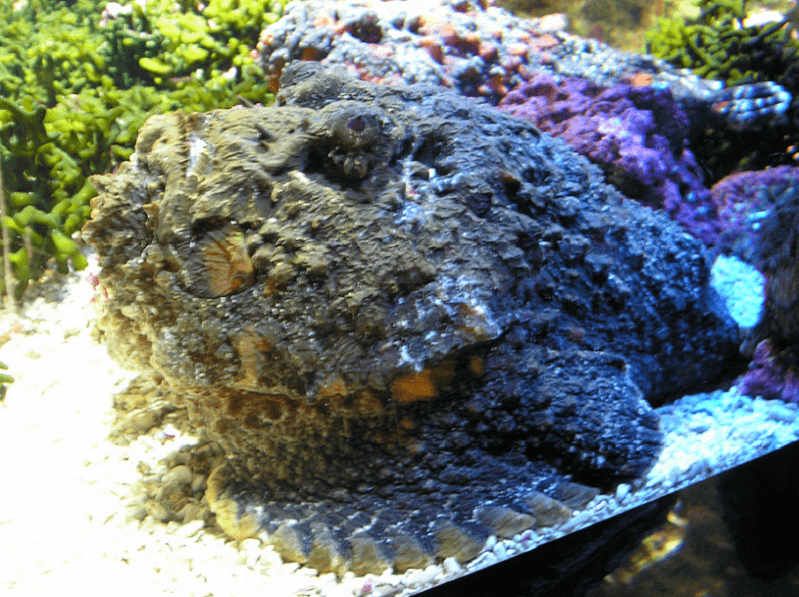Crocodilefish Facts
- The definitely attention-grabbing term of Crocodilefish serves as one of the accepted common names for this remarkable marine species. It also goes by another common name, though. That alternate name’s the equally distinctive Tentacled flathead.
- Its scientific name, meanwhile, remains almost unpronounceable. That’s because it bears the tongue-twisting official designation of Papilloculiceps longiceps. By either of these terms, however, it’s undeniably a visually distinctive species.
- The French naturalist and zoologist, Georges Cuvier, made the first official recognition of the animal as a separate species. This landmark event took place in 1829. Quite surprisingly, despite his body of work, he strongly opposed the concept of evolution.
- Fortunately, the Crocodilefish also appears to be maintaining a fairly sizeable and stable population. The fascinating creature further seems to be doing so throughout the entirety of its natural range. It’s also now spread to other areas of the globe.
- It’s believed it migrated through the man-made access provided by the Suez Canal. This, however, provided it with the opportunity to expand beyond its native range, albeit artificially. The IUCN, due to these combined factors, lists it as Least Concern.
- Although its current situation seems secure, that could change. That’s because, like most of the forms of life on earth, it now faces new threats to its continued existence. While these vary, the greatest threat no doubt comes from ongoing climate change.
Related Articles



Crocodilefish Physical Description
Although it’s true that the Crocodilefish creates a highly imposing and intimidating appearance, it doesn’t do so due to sheer size. That’s because it actually ranks as a small variety of marine fish. Nature, it seems, places no importance on size in its various creations.
The remarkable fish further displays a moderate degree of the physiological trait of sexual dimorphism. In its particular case, this characteristic manifests itself in terms of simple size. More specifically, males of the species generally attain a greater length than females.
The difference remains relatively small, though. Overall, however, it averages roughly 19.7 in (50 – 60 cm) in total length. Exceptional specimens do occur, however. These singularly impressive individuals sometimes reach lengths of as much as 27.5 in (70 cm).
In appearance, meanwhile, individuals of both genders achieve the same general pattern. Overall, the Crocodilefish presents a mottled combination of gray, green, and brown. This coloring, along with a knobby skin surface, gives it excellent camouflage in its habitat.
- Kingdom: Animalia
- Phylum: Chordata
- Class: Actinopterygii
- Order: Scorpaeniformes
- Family: Platycephalidae
- Genus: Papilloculiceps
- Species: P. longiceps
Crocodilefish Distribution, Habitat, and Ecology
Perhaps most notably, the current range of distribution of the amazing Crocodilefish now exceeds its original one. Even now, however, its territorial range remains comparatively restricted. Its entire range still fits entirely within the Eastern Hemisphere.
More precisely, though, its native range consists solely of the Red Sea, in the Western Indian Ocean. Now, however, the actions of man have allowed it to spread to portions of the Mediterranean. For the moment, it does not appear to be expanding any further than that.
Regardless its exact location, though, the creature demonstrates a decided preference in its choice of habitat. Throughout the entirety of its range, both natural and artificial, it lives on the ocean bottom. It does nevertheless appear there only in shallow depths, near reefs.
The fascinating Crocodilefish hunts exclusively as a predatory carnivore. On the sandy sea floor, its natural appearance allows it to lay in wait for unsuspecting prey to approach. From its concealment, it strikes, eating virtually any fish small enough to fit in its mouth.
Species Sharing Its Range



Check out our other articles on 5 Remarkable Canadian Mammals, Crowned Eagle, Caverns of Sonora, Holy Ghost Orchid, Emerald Swallowtail, Satanic Leaf-Tailed Gecko, Purple Frog












Leave a Reply